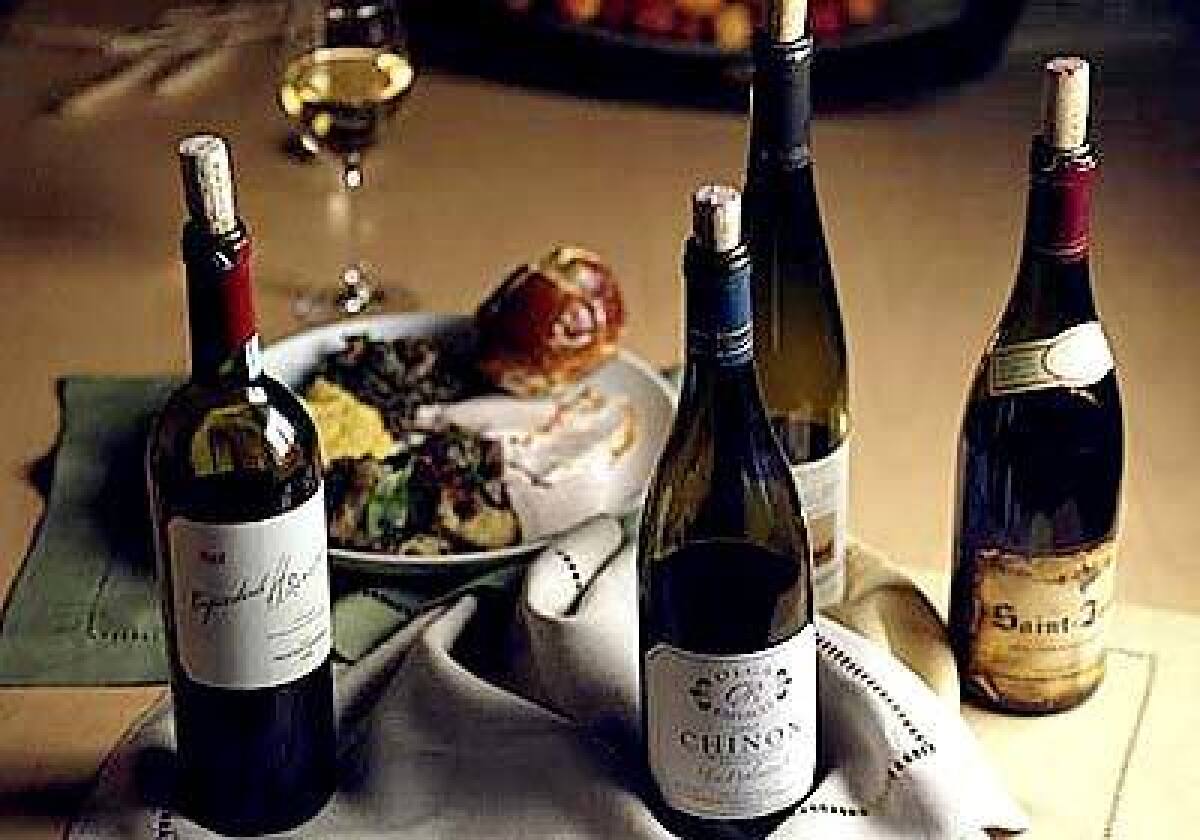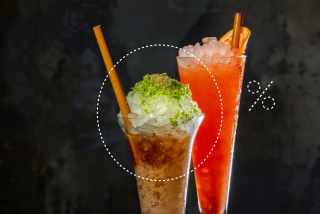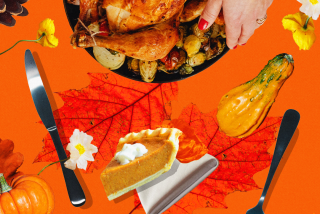Congeniality by the bottle

It’s the eternal question: What to drink with Thanksgiving dinner?
Every year, the pundits of wine-and-turkey-matching put forth their picks: Zinfandel, they suggest perkily; after all, it’s a native American grape. Or Riesling: A safe bet, since it’s generally food friendly and tends to work with sweet and spicy dishes. Or Beaujolais Nouveau — very Thanksgiving-y, since the new vintage is released virtually on the eve of the holiday. Or Pinot Noir — that, conventional wisdom dictates, goes with everything.
But is there a wine writer between Lodi and the Finger Lakes who has actually tasted, in a focused way, a whole slew of different wines with an actual Thanksgiving dinner? Or are they just, well, guessing?
Two weeks ago, our tasting panel sat down to a real, nontheoretical, lavish Thanksgiving meal, prepared by the Times Test Kitchen using the recipes from chefs featured in this issue. Our aim was to sample a wide range of wines and find out what works best with the cacophony of wonderful flavors that is the Thanksgiving plate.
From the rich turkey to the spiced sweet potato purée, from the earthy collard greens with bacon and lentils to the tangy bread salad with dried cranberries, arugula and pecans, the range of flavors, textures, sweetness and acid is all over the map — as it always is this holiday.
The potato gratin layered with wild mushrooms is luxurious; you could drink that with a white Burgundy or a serious red Bordeaux and be very happy. But take a bite of cranberry jelly, and your palate would go haywire as the wine short-circuits.
We left out the appetizers and the dessert from this experiment, figuring that if we could find a table wine (or two or five) that worked with the main plate, we’d be in fat city. But we can say with confidence that Thomas Keller’s salmon rillettes and shrimp and avocado bites are an easy match: Champagne. Or an un-oaked Sauvignon Blanc such as Sancerre. Or a lightly oaked California Sauvignon Blanc.
For dessert, a tawny Port would be heavenly with Sherry Yard’s multi-tiered pumpkin torte; or skip the wine with it, and have a glass of Bourbon or Scotch or Armagnac afterward.
The ultimate test
To find the ideal Thanksgiving wine, we gathered 27 wines from around the world. They included 13 grape varieties from nine regions and were priced from $9.50 to $27. We set the table with glasses — lots of them — and place settings. Times Test Kitchen Director Donna Deane and her staff cooked up a storm and arranged the Thanksgiving buffet. We filled our plates and sat down. We tasted.Going into the project, the panel, which included columnists Russ Parsons and David Shaw, restaurant critic S. Irene Virbila, staff writer Corie Brown and assistant editor Laurie Winer, all expressed personal preferences for red wine with Thanksgiving dinner. Yet all of us were amazed at how well some of the white wines worked with the range of flavors on the plate.
We were particularly wowed by Pinot Gris from Alsace (also known as Tokay Pinot Gris).
These wines tended to have enough assertive aromas and flavors to stand up to the rich, salty and sweet food, and enough supple texture to be substantial with the food, smoothing the transitions. And one panelist put it, “Their refreshing acidity clears your palate for every next bite.”
A 2001 Domaine Bott-Geyl Pinot Gris Beblenheim, $16, and a 1999 Rolly Gassman Tokay Pinot Gris Rotielbel de Rorschwihr, $22, were just the ticket. They worked so harmoniously with the foods that we guessed that other Alsace Pinot Gris would also be great matches.
A Vouvray from the Loire Valley paired similarly well. On the other hand, a white Rhône blend and a blend of Chardonnay and white Rhône varieties, both from Paso Robles, fell flat with the flavors on the plate: The wine did nothing for the food, and the food did nothing for the wine.
A white Anjou was delicious on its own, but its delicate aromas and flavors were overwhelmed by the gratin and the Savoy cabbage. A bone-dry Riesling from Germany’s Pflaz region was an acceptable match, but its austerity prevented it from wowing anyone as a match with the table’s assertive tastes.
When it came to reds, there were a few surprises.
The American Pinot Noirs we tasted — a 2002 Hartford, $22, from the Sonoma Coast and a Witness Tree, $19, from Oregon’s Willamette Valley — didn’t work at all with the food: The wines were too thick in texture, coating the tongue.
It’s possible, we agreed, there might be some American Pinots that would have the appropriate fruit and wouldn’t be too heavy for the meal. But if there are, they’d likely be at a price point that most people wouldn’t want to approach for a large Thanksgiving party.
Contrary to an oft-stated belief, Zinfandel, with its high alcohol level, was a total disaster with the food. (We sampled two — a 2001 Franus from Brandlin Vineyard in Mount Veeder, $17, and a 2002 Palm Cellars, $22, from Paso Robles.) With the richness of the food, even a few sips of it were a drag on the palate.
We agreed that what we needed was a red that drinks easily, has plenty of fruit, yet isn’t super concentrated; it shouldn’t fight with the food. It should be fairly young and have a generous bouquet.
This is not the moment to bring out your showpiece wines, for any delicacy will likely get lost in the smorgasbord of flavors.
Our ‘aha!’ moment
The panel agreed that the most successful and dependable wines for the meal were Beaujolais crus. These are the light reds (from a subregion of southern Burgundy) that are named for the villages — or crus — where their grapes are grown.Two 2003 Beaujolais crus, a Fleurie and a Morgon, at $18 each, were the stars of the tasting.
They were delicious and drinkable, with pretty cherry and plummy aromas and delicious red fruit flavors that harmonized nicely with all of the flavors on the plate, including the dried cranberries in the bread salad.
They had enough bright acid to stand up to the salad’s vinaigrette, as well as to cut through the richness of the turkey and the potato gratin. Also, they were both refreshing and earthy enough to work with the salty bacon in the collard greens and the rich sweetness of the sweet potato purée.
We also tasted a $12 wine with a Beaujolais-Villages appellation, a 2003 Trénel Fils. While it didn’t clash with anything, it didn’t have the character to stand up to the plate the way the Beaujolais crus did.
Another category that paired nicely was village wine from the Rhône Valley, three wines from Saint-Joseph in particular (a 2001 J.L. Chave and a 2000 Bernard Faurie, both $27, and a 2001 Domaine Richard old-vines Les Nuelles, $18). Though we didn’t taste a Gigondas, which we also imagined might work, a terrific $10 non-vintage red table wine from noted Gigondas producer Louis Barruol, labeled “Little James Basket Press,” was good, but didn’t sing with the table’s flavors as did the Saint-Joseph
A dependable $9.50 Côtes du Rhône from E. Guigal came off as a little thin with the food.
It came as no surprise that a red from the Loire Valley would get along nicely; these Cabernet Francs are always food-friendly. A 2002 Olga Raffault Chinon “La Poplinière,” $17, had plenty of fruit and a supple texture that was marvelous with just about everything on the plate.
And modern Riojas, with their vibrant fruit and soft tannins, are another good choice — a 2001 Propriedad H. Remondo, $25, was a delicious companion.
A number of us had thought that a couple of wines from Italy’s Piedmont region would be felicitous Thanksgiving wines: Dolcetto and Barbera. We were wrong. Although they were terrific on their own, their flavor profile wasn’t right with the food; they fell flat.
Since we were so excited by the congeniality of the Beaujolais crus, we planned a second tasting of an assortment — a focused, blind tasting without food — in order to give specific recommendations. (See sidebar.)
It would be wonderful, we thought, to have a bunch of different Beaujolais crus — a Morgon, a Fleurie, a Moulin-à-Vent, a Brouilly — for the Thanksgiving table.
More to Read
Eat your way across L.A.
Get our weekly Tasting Notes newsletter for reviews, news and more.
You may occasionally receive promotional content from the Los Angeles Times.






